How to knock out 76 tanks in one day? German champions on the Oder front
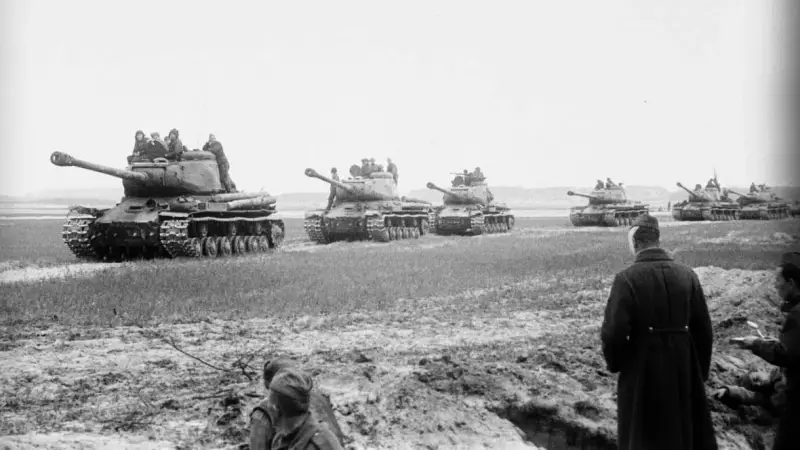
Combat activities and personal accounts of the German tank aces of World War II have always caused a lot of controversy. Among the German tank aces there were both lucky and experienced veterans who went through the entire war, and relatively young newcomers who got to the front at the very end of the war, but managed to surpass many of their more experienced colleagues in the number of enemy tanks destroyed in a relatively short period of time.
One of these young and early tank aces was the commander of a tank platoon of the 503rd SS heavy tank battalion (s.SS-Pz.Abt.503), SS Hauptscharführer Karl Körner, born April 19, 1920. On his combat account, there are, according to various sources, 101 or 102 destroyed Soviet tanks. Moreover, all his victories were achieved literally in the last month of the war. Serving in the SS troops since 1940, the future tank ace Karl Körner mainly served in various spare and training units of the Viking and Nordland divisions, until 1943.
Further, Kerner underwent retraining as a tanker and was enlisted in the new 103rd SS heavy tank battalion (s.SS-Pz.Abt.103). The battalion was formed in November 1943 and, in fact, was a training unit that trained SS tankers for service on heavy Tiger tanks. In this battalion, Koerner successfully served until September 1944, when the battalion changed its number to the 503rd and began to be equipped with King Tiger tanks.
And finally, in January 1945, Koerner, along with his battalion, was sent to the Soviet-German front as part of the Vistula Army Group. In February-March 1945, Koerner, who had no combat experience, as well as the experience of tank battles, was not reported in German front-line reports about the special successes.
Sudden success came to Koerner only in April 1945, when during the Soviet offensive on Berlin, “victories” rained down on him like a cornucopia, and on his 25th birthday he announced the destruction of 76 Soviet tanks at once in just one day.
The purpose of this article is an attempt to figure out whether these claims correspond to reality, or are they just someone's fantasies and attempts to wishful thinking.
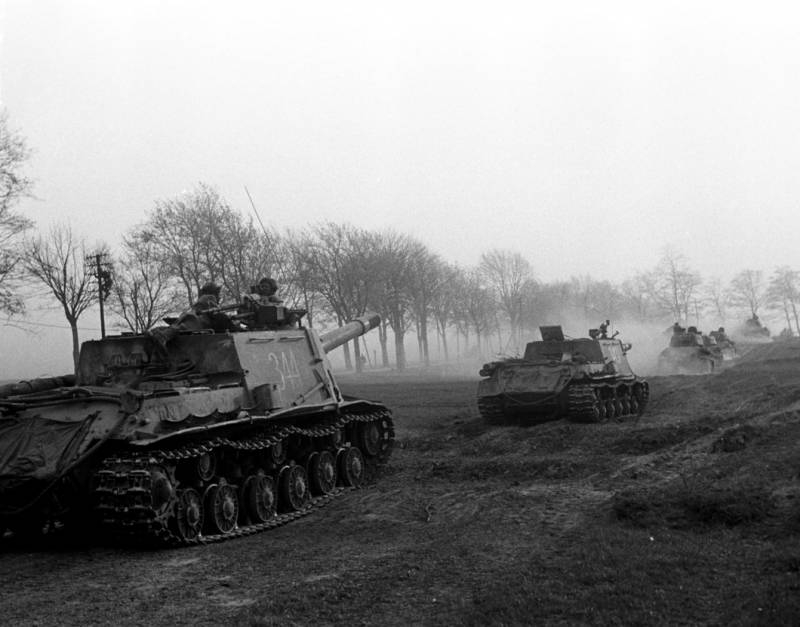
Soviet self-propelled artillery ISU-152 and tanks are moving towards the front line
German version of events
According to confusing and fragmentary German data, mainly from the memoirs and memoirs of German tank veterans of the 503rd SS tank brigade, it is known that on April 18, 1945, all 11 combat-ready tanks of this battalion took up positions in the defense zone of units of the SS division "Nordland" at the Prötzel line — Bollersdorf. When repelling attacks by Soviet troops, the crews of the Royal Tigers on that day announced the destruction of 64 Soviet tanks, and, according to the memoirs of Lothar Tilby, the driver of one of the Royal Tigers, 11 tanks from this number were knocked out by the crew of one "Royal Tiger", which took up positions along the road from Bukov to Hasenholz.
The next day, April 19, one tank of the 503rd SS TTB, damaged the day before, was abandoned by personnel, and the crews of the 10 remaining tanks of the battalion stated that they disabled about 150 more Soviet armored vehicles during the day.
Here it is necessary to make a digression and explain that all these applications were made by tank commanders, were not subsequently checked by anyone, were not confirmed by any documents, but were widely disseminated for propaganda purposes. In fairness, it should be noted that in a tense combined-arms battle it is quite difficult and not always possible to keep an accurate count of the enemy tanks knocked out, and even more so to accurately determine who exactly knocked out this or that tank, since several tank or artillery can fire at one tank at once trunks.
During these battles, the commander of the Royal Tiger No. 314, SS Unterscharführer Georg Diers, stated that 13 Soviet tanks were destroyed east of Klosterdorf.
In positions between Grunov and Bollersdorf, a group of five "Royal Tigers" under the command of SS Obersturmführer Fritz Müller (Fritz Müller) destroyed about 30 Soviet tanks, 23 of which were listed on Müller's battle account. True, on the same day, not having time to enjoy the success and being outside the tank, Muller was hit by a volley of Soviet Katyushas and was killed.
After this group of tanks ran out of ammunition, it retreated to the rear to replenish ammunition, and it was replaced by a group of three more "King Tigers" under the command of a platoon commander of the 2nd company of SS Hauptscharführer Karl Körner. This group knocked out some more Soviet tanks.
Soon, around 17:00 Berlin time, in the area west of Bollersdorf, Kerner noticed a group of Soviet tanks replenishing with fuel and ammunition, identified by him as T-34-85 and IS-2, in the amount of 120-150 vehicles (that is, in terms of numbers - slightly shabby tank corps), of which the crews of three "Royal Tigers" of the Kerner group, having shot the last remaining shells, allegedly knocked out 64 tanks. 39 tanks were brought to Koerner's personal account (including 13 IS-2s), and 25 tanks to SS Hauptscharführer Harrer's account.
What the crew of the third "Royal Tiger" of the group did in this battle, which did not knock out a single tank, remains a mystery. Apparently, he covered the rear or gave all his shells to two comrades. It remains unclear where the rest of the Soviet tanks went and why they did not return fire. Probably, the Soviet tankers were too shocked by the events taking place.
Toward evening, the same three tanks from the Koerner group, with the support of another tank, the commander of which was the commander of the 3rd company of the 503rd SS SS Untersturmführer Oskar Schäfer, who had returned from the hospital, together destroyed about 30 more Soviet tanks, who, like lemmings, died by the hundreds, but, not paying attention to losses, stubbornly moved forward.
After sunset on the night of April 19-20, the attacks of numerous Soviet IS-2 tanks resumed, but many of them were hit in the night battle by the “King Tigers” of the 503rd SS TB, which were eventually forced to retreat to Strausberg. Apparently, the tired German tankers were no longer able to endure the massive attacks of the Soviet IS-2s.
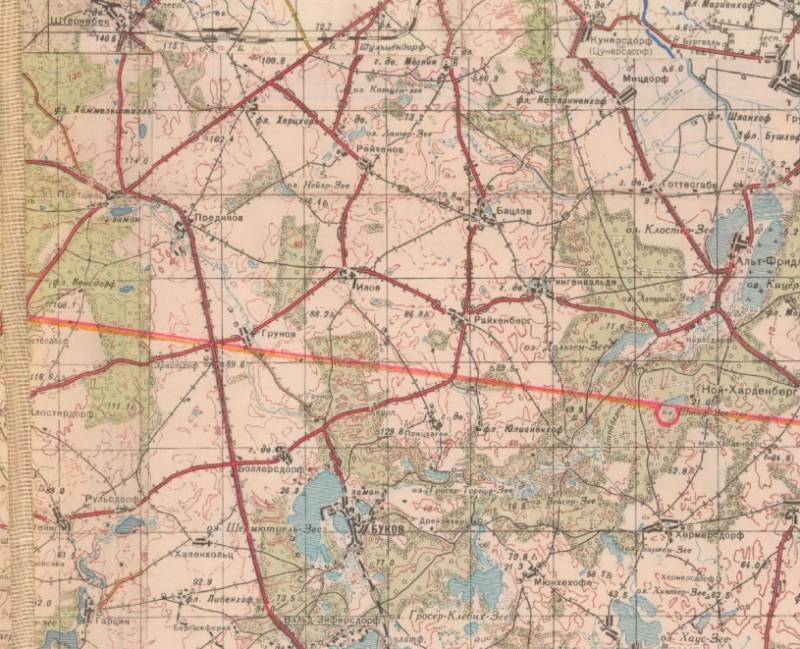
Fragment of a map with the area of operation of the "Royal Tigers" of the 503rd SS TTB
As a result, in just one day, spent on a new sector of the front, the newly-made tank ace Karl Körner reported on the destruction of 76 Soviet tanks and later, having increased his score already during street battles in Berlin, for the destruction of more than 100 Soviet tanks was awarded the much coveted Knight's cross. He received the award on April 29, 1945 in the Reich Chancellery from the hands of SS Brigadeführer Wilhelm Mohnke, along with two more tank officers of the 503rd SS TB, who were the battalion commander SS Sturmbannführer Fritz Herzig (Fritz Herzig) and the commander of the 3rd company of the battalion, SS Untersturmfuhrer Oskar Schafer.
Some fans of the epic feat of Kerner, as proof of his words, cite the loss figures of the 1st Belorussian Front for April 19, amounting to 105 burned out, 76 wrecked and 8 tanks and self-propelled guns lost for other reasons.
It can be answered that all the tanks of the 503rd SS TTB operated on the same sector of the front, fighting in a strip no more than 10 kilometers wide, where only tank and self-propelled units and formations of the 5th shock army and the 2nd guards tank army advanced , and not all of them. And besides which, the 1st BF included nine more armies and two cavalry corps, all with armored vehicles. Therefore, to record the losses of all the armies of the front on the actions of 10 German tanks would be rather stupid and presumptuous.
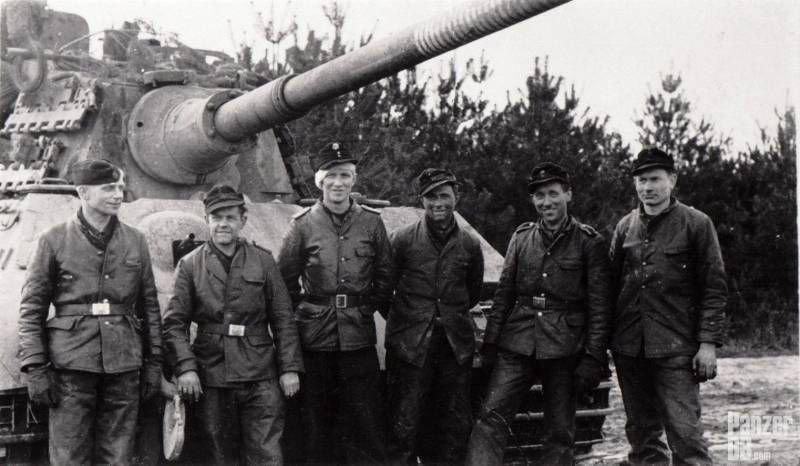
Tankers of the 503rd SS heavy tank battalion against the background of the "Royal Tiger" with victory rings on the barrel. In the center with a bandage on his head is another well-known ace of the battalion, the commander of the 1st company, Untersturmführer Karl Brommann
Disposition before the fight
Next, according to the archival documents of the armored units of the 1st Belorussian Front, we will consider how the events developed on April 19, how those tank units of the front acted that attacked in the defense zone of the 503rd TTB SS and for which April 19 was the day of the greatest losses in armored vehicles for the whole operation.
At that time, it was not customary to treat German tank units with disdain, but about the actions of German tankers, for example, in the report of the 369th Guards. tsap says the following:
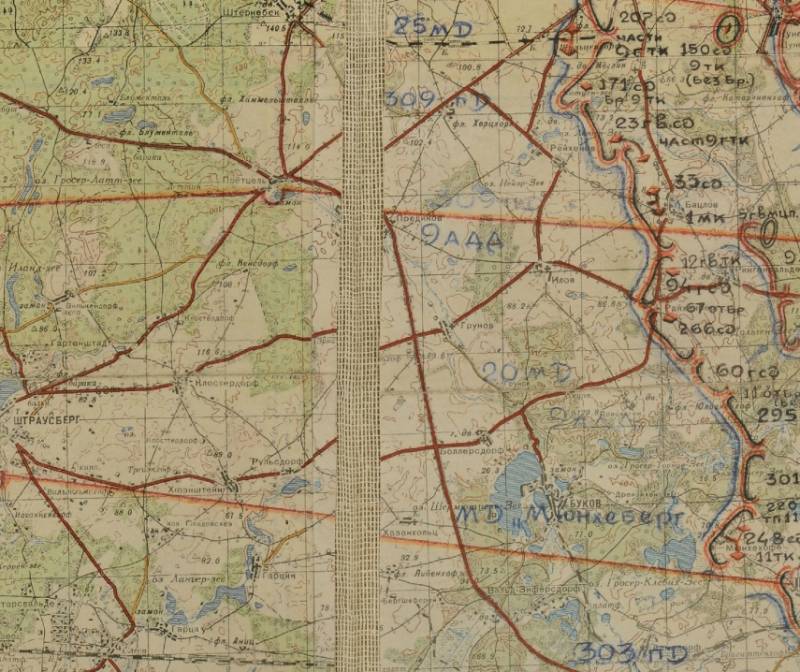
Fragment of a map showing the position of the Soviet and German units on the morning of April 18, 1945. It was on this sector of the front in the Prötzel-Bollersdorf area that the "Royal Tigers" of the 503rd SS TTB operated
So, in the area of Prötzel - Predikov - Grunov - Bukov, where the described events took place, according to Soviet data, the 3rd defensive line of the enemy passed, consisting of two main trenches connected by communications, with machine-gun and mortar platforms. Behind the 2nd trench were machine-gun bunkers, and at mark 89,8 (southwest of the Grunov farm) tanks of the Tiger type and assault guns were installed in caponiers. Artillery 3rd lane was poorly saturated. The main nodes of the German defense were settlements, the approaches to which were covered by forest debris and numerous anti-tank positions and tanks and self-propelled guns dug into the ground.
According to the protocols of interrogation of captured soldiers of the SS division "Nordland", by the evening of April 18, the SS regiment "Norway" (SS-Pz.Gren.Rgt.23 Norge) took up defense south of Ilov, and the SS regiment "Denmark" (SS-Pz.Gren. Rgt.23 Danmarck) - to the north. The tank battalion of the Nordland division (SS-Pz.Abt.11 Hermann von Salza) was located in the Klosterdorf area.
As of April 17, according to German data, the SS Nordland division had 2 Panther tanks, 23 Stug 40 Ausf.G assault guns and 10 new Pz.IV / 70 (V) tank destroyers that arrived in early April, but it is not known , how many of these armored vehicles, experiencing a lack of fuel, could take part in the battles on April 19.
By the way, the last two Ausf.D Panthers miraculously remaining in the division (former vehicles of the 1st SS TD, then transferred to the Oranienbaum tank battalion) of the very first issues went through a rather long combat path, which began at the end of 1943, when they arrived near Leningrad . Interestingly, according to the intelligence report of the 5th UA:
Also, the 18th Panzergrenadier Division (18.Pz.Gren.Div.) was deployed to this sector, the tank battalion (Pz.Abt.118) of which on April 16 consisted of 27 Pz.IV Ausf.J tanks and 8 tank destroyers Pz. IV / 70 (V), and the anti-tank battalion (former Pz.Jg. Abt. Schlesien) - 19 Jagdpanzer 38 (t) self-propelled guns, better known as the Hetzer.
On this sector of the front, the Soviet units of the 5th shock and 8th guards armies were advancing, reinforced by tank units, respectively, of the 2nd and 1st guards tank armies. The main enemy for the German tankers were units of the 5th UA and 2nd Guards. TA, whose offensive line passed through the area we needed, and most of the formations of the 8th Guards. And the 1st Guards. The TA were advancing much further south, only part of the forces of the 11th Panzer Corps acting at the junction of the armies on the Vulkov-Bukov line.
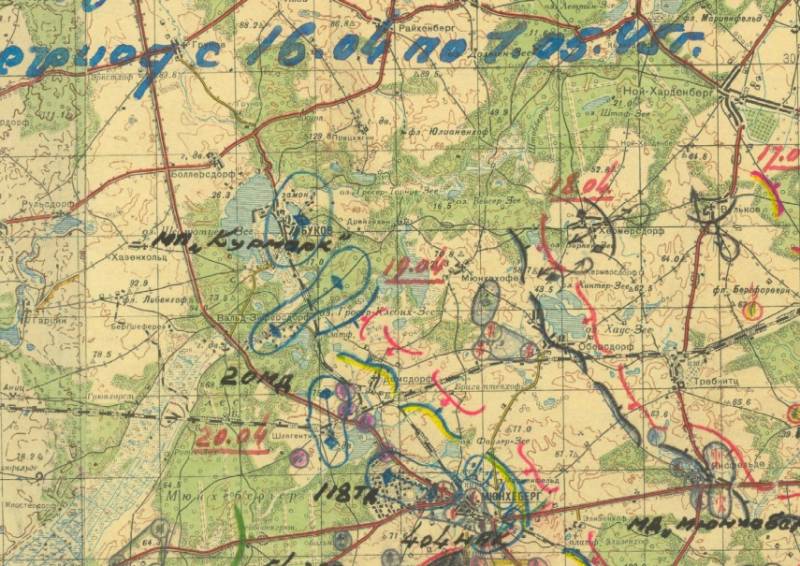
Fragment of the map of the 1st Guards Tank Army. The formations of the army operated south of the Vulkov-Bukov line, in the direction of Müncheberg, and could not meet with the tanks of the 503rd TTB SS
From the buildings of the 1st Guards. TA, theoretically, only a part of the units of the 503th TC, which had reached the Grunov area by that time, could theoretically meet in battle with the “Royal Tigers” of the 19rd SS TB not earlier than the evening of April 11th.
From the morning of January 11, units of the 18th Tank Corps continued to advance from the Vulkov-Alt-Rosenthal line in the general direction to Bukov, occupied Trebnitz and Hermersdorf, but by the evening they met stubborn enemy resistance at the Münchehof-Obersdorf line. All day on April 19, parts of the corps tried to develop the offensive and by the evening fought on the Münhehof-Damsdorf line, but had no success. After that, it was decided to bypass the main resistance node - Bukov, from the north and south, having the main grouping of corps forces in the north.
Turning to the north and through Reichenberg and Ilov, by the end of the day the right group (65th brigade, 50th guards. ttp, 1461st and 1493rd sap, 12th msbr, 243rd mp, 1071st paws , division of the 79th Guards Rep, two batteries of the 1388th zenap) went to the area of the Grunov farm, and the left group (20th and 36th brigade, two batteries of the 1388th zenap) went to the western outskirts of Müncheberg. This maneuver of units of the 11th Tank Corps forced the enemy to leave Bukov and retreat to the west. On April 19, units of the 11th Tank Corps lost 8 T-34 tanks burnt out and 5 wrecked, and the 65th Tank Brigade lost only one T-34 burned out and one knocked out. In the 50th Guards. TTP, 1461st and 1493rd Sap there were no losses at all that day.
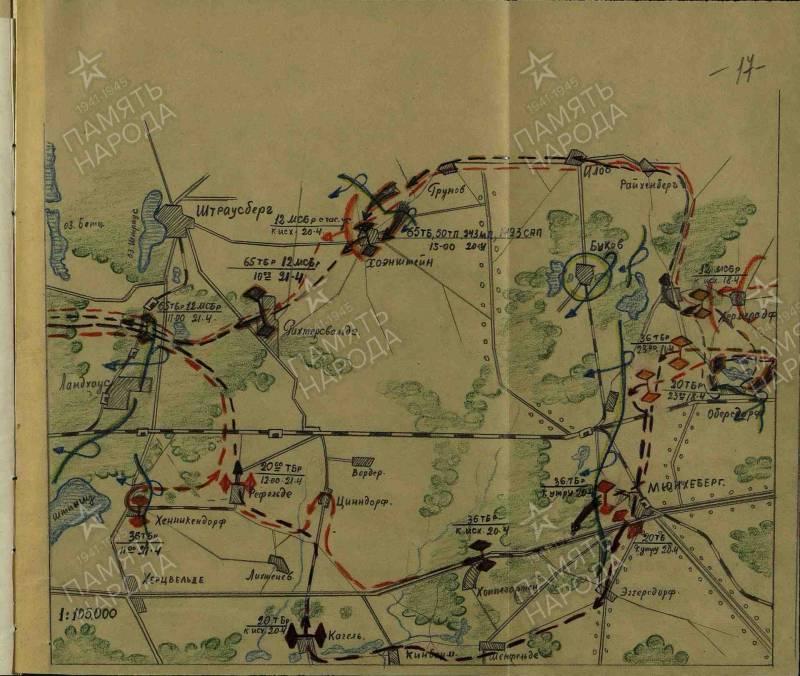
Scheme of actions of units of the 11th tank corps of the 1st guards. TA. The corps was the only army formation, parts of which could meet with the tanks of the 19rd SS TTB near Grunov on April 503
Parts of another tank corps of the 1st Guards. TA - 11th Guards. shopping malls during April 18 and 19 acted to the south, in the Jansfelde-Müncheberg area, and parts of the 8th Guards. MK fought east of Müncheberg, in the Friedersdorf-Marksdorf area, and they could not meet with the tanks of the 503rd SS TTB, even theoretically.
Operating in the same lane with the 1st Guards. TA tank and self-propelled units of the 8th Guards. And they also acted either much to the south of the area we needed, or were in the second echelon, or remained in reserve, and their losses with the actions of the crews of the "Royal Tigers" of the 503rd SS TB were in no way connected.
April 19, 1945: actions of units of the 2nd Guards Tank Army
Of the three buildings of the 2nd Guards. Only two corps could meet with the "Royal Tigers" of the 503rd SS TBM: the 1st Mechanized Corps and the 12th Guards Tank Corps, while the 9th Guards Tank Corps operated a little to the north, and on April 19 its losses amounted to only 9 T-34 tanks burnt out and 3 damaged.
April 19 connections of the 2nd Guards. TA continued their advance in a westerly direction, and by 21:00 pm in the area of interest to us, the 19th brigade and 219th brigade of the 1st MK were operating, by 19:30 they occupied Prötzel, and units of the 12th Guards. shopping mall, from 21:00 trying, together with the infantry of the 26th sk, to advance from the Grunov area in the direction of Klosterdorf.
In the Prötzel area and in the nearby forest, according to Soviet data, units of the 309th Infantry Division were defending themselves, reinforced by a large number of artillery, with up to 10 tanks and self-propelled guns. According to German data, on April 15, the 309th Berlin infantry division had 9 StuG 40 Ausf.G assault guns and 11 Hetzers.
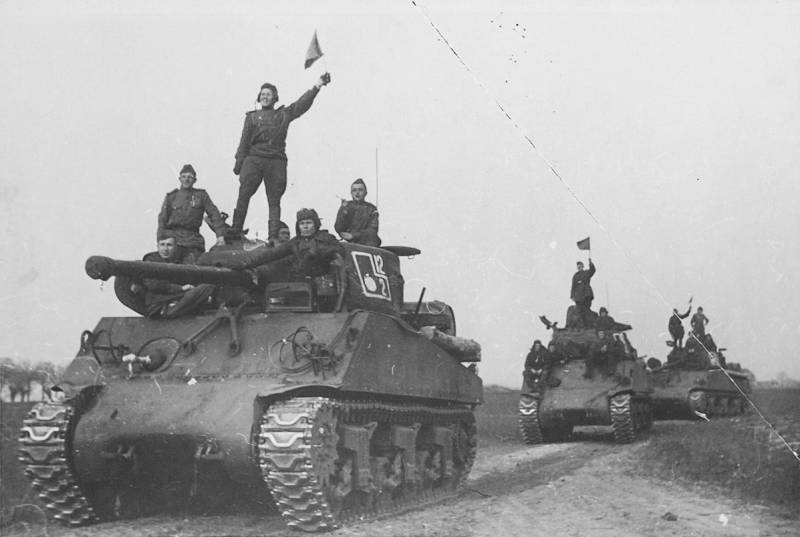
M4A2 tanks of the 1st mechanized corps
Parts of the 1st MK, waging night battles, by the morning of April 19 broke the enemy’s resistance and, having occupied Batslov and Ilov, continued their offensive. The 219th brigade operated in the direction of Predikov, the 19th brigade - in the direction of Prötzel, and the 35th and 37th brigade, which were heading, went north, to the Reichenov-Sternebek area. In the same direction, even further north, units of the 9th Guards. mk.
The 219th brigade, in cooperation with the 19th brigade, by the end of April 18, fought through the settlements of Vulkov and Hermersdorf, losing 7 M4A2 tanks knocked out in a day.
On April 19, the 19th MBR, overcoming the resistance of small groups of submachine gunners and enemy Faustniks, occupied Reichenov, the Herzhorn farm and by 15:00 reached the line 1 kilometer northwest of Prötzel.
In the Herzhorn area, the tankers of the 9th tank regiment of the brigade suddenly jumped out onto an enemy artillery column and crushed 7 guns during a fleeting battle. The attempts made to break into Prötzel and Predikov on the move did not bring success. During the day, the brigade lost 1 M4A2 tank burned out and another 2 knocked out.
By 15:30 on April 19, the 219th brigade reached the Predikov area, where, according to intelligence data, up to two infantry companies with several anti-tank guns and 2 self-propelled guns were defending. By a roundabout maneuver, the enemy was knocked out of the Predikov, and by 16:00 the 219th brigade approached Prötzel, which the 19th brigade failed to occupy, and to the forest area located to the west.
Pretzel stubbornly defended with up to an infantry battalion, supported by two batteries of field artillery and one anti-aircraft battery. By evening, the enemy was partially knocked down from the occupied line, and the 219th brigade bypassed Prötzel, losing 3 M4A2 tanks knocked out in a day. By 19:30, as a result of joint actions of the 19th MBR and the 219th Brigade of the 1st Mk and the 49th Guards. brigade of the 12th guards. since the settlement of Prötzel was cleared of the enemy.
In the Prötzel area, after fighting with units of the 19th MBR and 219th Brigade, the last two Panthers of the SS Nordland division were lost, possibly damaged in battle or abandoned due to lack of fuel. Tankers of the 219th brigade announced the destruction of two "Tigers" (3 "Panthers" appear in another report) and three self-propelled guns in the Prötzel and Predikov area.
Two self-propelled artillery regiments of the 1st MK: the 75th and 1822nd saps, operated jointly with the 35th and 37th battalions north of the area of operation of the tanks of the 503rd SS ttb and could not cross with them, and the 347th guards On April 19, the tsap was in the reserve of the corps and went in the second echelon through Reichenberg and Ilov, reaching the Herzhorn farm by 18:00. The regiment did not fight that day, and during the entire operation it lost only 2 ISU-122 burnt out and 2 wrecked. In total, according to the operational report of the headquarters of the 1st MK, 7 M4A2 tanks and 2 SU-76 self-propelled guns were lost per day by parts of the corps.
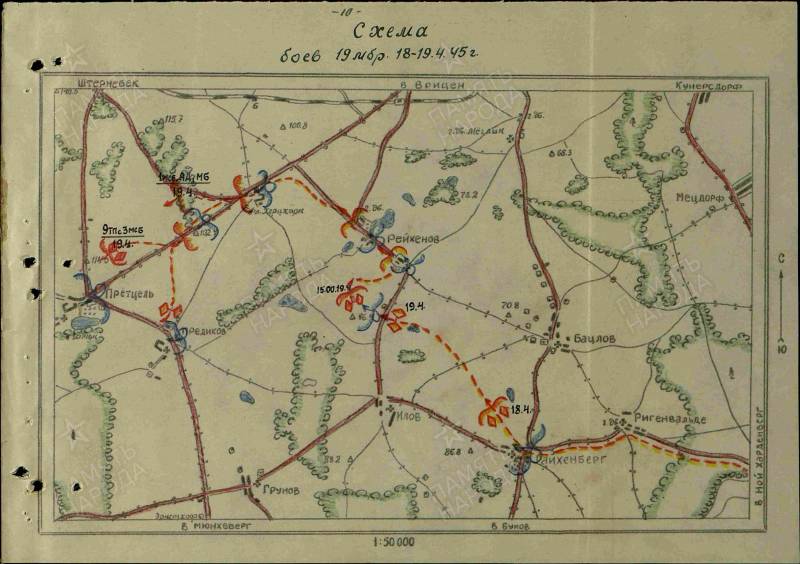
Scheme with the actions of the 19th mechanized brigade of the 1st mechanized corps for April 18 and 19, 1945
Parts of the 12th Guards. shopping malls were supposed to advance through Ilov from the line east of Reichenberg and occupy Grunov. According to the headquarters of the corps, at 17:00 on April 19, units of the 34th Guards. MSBR and 48th Guards. The brigade was occupied by Grunov, defended by a battalion of enemy infantry with the support of tanks and a large number of anti-tank guns.
According to the report of the 48th Guards. brigade, the brigade was forced to storm Grunov on its own, without infantry and artillery support. As a result, the settlement was occupied, but the brigade suffered heavy losses. And the 66th Guards. The brigade, which was supposed to attack the Grunov from the southeast, did not take part in the battle and did not provide assistance in the assault.
Further advancement of the 48th Guards. The brigade was suspended due to strong enemy anti-tank fire, which was fired from a forest area located west of Grunov, the approaches to which were covered with forest debris. Therefore, the 48th Guards. The brigade temporarily went on the defensive on the western outskirts of Grunov. The losses of the brigade on April 19 amounted to 17 T-34 tanks burned out and 2 knocked out, while the destruction of one Tiger tank and three 75-mm anti-tank guns was announced.
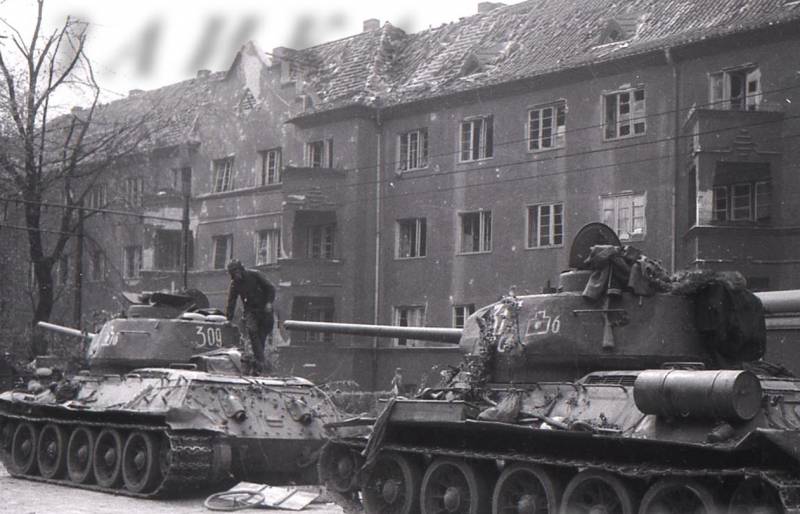
Tanks T-34-85 of one of the brigades of the 12th Guards Tank Corps in the spring of 1945
49th Guards. brigade with SU-100 self-propelled guns of the 393rd Guards attached to it. sap, developing an offensive in a western direction, by 20:00 on the evening of April 18, after a two-hour battle, occupied Reichenberg and, continuing to move, broke into Ilov on the move, where they fought with enemy tanks and artillery throughout the night. Only by 8:30 am on April 19, the units of the brigade occupied Ilov and, continuing the offensive, reached the eastern outskirts of Predikov, where the enemy stubbornly defended every house, delivering heavy fire from tanks and artillery.
After a heavy seven-hour battle, having no infantry support and suffering losses, the brigade nevertheless knocked out the enemy, and by 17:00 the village of Predikov was occupied. Moving on, the 49th Guards. By 22:00, the brigade went to Prötzel, turned by the enemy into a powerful center of resistance, and, having taken up defensive positions, conducted reconnaissance of bypass routes all night. During the fighting on April 19, the brigade lost 4 tanks burnt out and 16 knocked out, declaring 4 destroyed German tanks and 21 guns. The next morning, the brigade fought its way into Klosterdorf, destroying eight 88-mm anti-aircraft guns without loss.
April 18 66th Guards. brigade together with IS-2 of the 79th Guards. ottp fought along the route Vulkov - Hermersdorf - Reichenberg and by 14:00 on April 19 was fighting in the forest, north of the mark 129,8 and the city of dv. Pritzhagen. By evening, the brigade, according to its report, approached Grunov, where it met the strongest resistance and by 20:00, together with other parts of the corps, occupied this settlement, although in the report of the 48th Guards. TBR clearly states that the tanks of the 66th Guards. brigade did not take part in the assault on Grunov. In two days on April 18 and 19, the brigade lost 8 T-34s burned out and 10 knocked out.
Total brigade of the 12th Guards. TK lost 19 T-57-34 tanks on April 85 (28 burned out and 29 wrecked), which was the largest loss of tanks on this sector of the front.
Theoretically, at least some of these tanks, which were put out of action in the battles in the Grunov area, could well have been victims of the fire of the “King Tigers” of the 503rd SS TTB, which operated in this area.
By the way, on April 19 there was a case of a false report by the commander of the 26th Guards. sk of Major General Firsov to the commander of the 5th UA, Lieutenant General Berzarin. In the report on the advance of the corps troops, it was reported that the Grunov settlement was occupied, and units of the 26th Guards. sk advanced two kilometers to the west, when in fact it was not so, for which Major General Firsov received a scolding.
April 19, 1945: the actions of the tank units of the 5th shock army
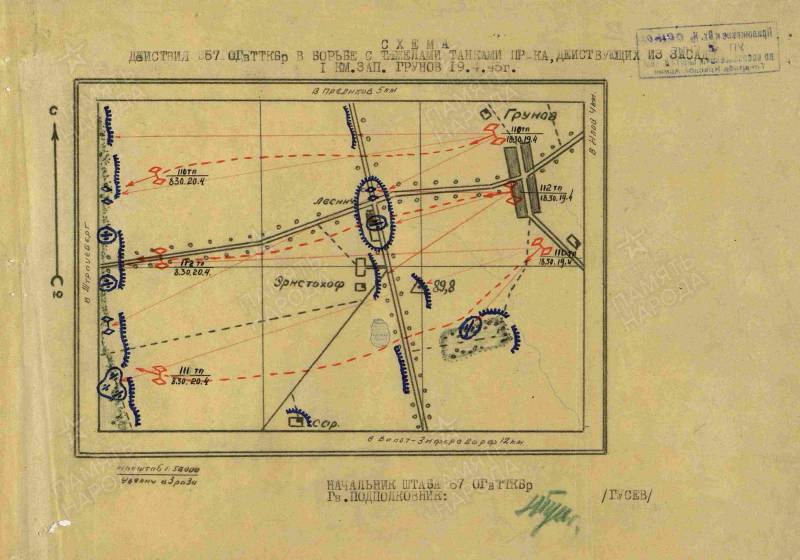
Scheme of actions of the tank regiments of the 67th Guards. ottbr April 19, 1945
During the fighting on April 18, units of the 5th UA reached the line of the Batslov-Reichenberg highway, where they met organized and stubborn resistance from the enemy.
Heavy tanks IS-2 of three regiments (110th, 111th and 112th) of the 67th Guards. During the offensive, the Otbr brigade acted together with ISU-152 self-propelled guns of the 396th Guards. tsap, which were assigned to the regiments of the brigade by battery, with T-34 minesweepers of the 92nd separate tank engineer regiment and infantry of the 286th guards. joint venture of the 94th guards. sd and 1010th joint venture of the 266th sd, which was planted on armored vehicles as a landing force. 67th Guards. Ottbr, which was the vanguard of the 26th Guards. sk, by 18:00 on April 18, she reached the edge of the forest east of Rigenwalde, where she met strong fire resistance. By decision of the brigade commander, infantry was landed on the IS-2 tanks as a landing force, and at 23:00 the brigade attacked the enemy.
During the night battle, the enemy withdrew from Rigenwalde to Reichenberg and, continuing the pursuit, the IS-2 tanks of the brigade attacked Reichenberg from the move. By 5:00 am on April 19, the settlement was taken by our troops, and the Germans withdrew to Ilov. Attack from the flanks by 9:00 am Ilov was taken, and by 13:00 67th Guards. ottbr went to the area east of Predikov. According to reconnaissance, Predikov was turned into a large center of resistance, tanks and self-propelled guns were dug in on its eastern outskirts, and the left flank was covered by anti-tank artillery fire from a grove located northeast of Predikov.
Within three hours, the IS-2 brigades attacked Predikov three times, but to no avail. Then an order was received to bypass through Grunov and Klosterdorf, followed by exit to the previous route. With a sudden blow, the brigade occupied Grunov at 18:30 and reached its western outskirts. On the edge of the forest and on the heights west of Grunov, the enemy concentrated a large number of anti-tank guns and buried tanks. Two attacks undertaken by the brigade did not bring success, and the brigade commander decided to retreat to his original position and regroup.
At 20:00, heavy tanks IS-2 of the brigade again attacked the enemy positions, but as a result of a tense battle that lasted until the very night, the brigade suffered heavy losses without achieving tangible success.
In the brigade's operational reports, counterattacks by German heavy tanks were noted, operating in groups of up to 6 units (most likely, these were the "Royal Tigers" of the 503rd SS TB). In the reports of the 94th Guards. On the evening of April 19, an enemy counterattack was also noted from the forest area west of Grunov, carried out by the forces of an infantry battalion with the support of 5 tanks and 2 armored personnel carriers, which was repulsed by artillery and mortar fire.
Only at 9:00 am on April 20, after a powerful artillery treatment of enemy positions by our artillery, the 67th Guards. The Otbr brigade was able to break through the enemy defenses in the area of the highway intersection 300 meters west of Grunov and occupy Klosterdorf, forcing the enemy to retreat in the direction of Strausberg. So, according to intelligence of the 94th Guards. sd, at 7:00 am on April 20, the enemy, having put his infantry on vehicles and having fired at the positions of our units from artillery and mortars, hastily withdrew in a westerly direction.
On the morning of April 18, in the ranks of the 67th Guards. The detachment had 50 IS-2 tanks, another 11 tanks were under repair, and 4 by this time had been written off as irretrievable losses. By 17:00 on April 19, the brigade's losses amounted to 4 IS-2 burned out and 3 knocked out.
During the night battles from 19 to 20 April, the brigade lost another 12 IS-2 burned out and 5 damaged, and only 24 combat-ready IS remained in service. Tankers of the 67th Guards. On April 19, 3 Ferdinands and 4 Tigers were declared destroyed.
It is possible that some of the destroyed IS-2 brigades were the result of the work of the "King Tiger" G. Dirs, who announced the withdrawal of 13 Soviet tanks east of Klosterdorf.
In units operating in conjunction with the 67th Guards. ottbr, the losses for April 19 were insignificant. 396th Guards. The tsap lost only 1 ISU-152 that burned down, and the 92nd ITP had no losses at all.
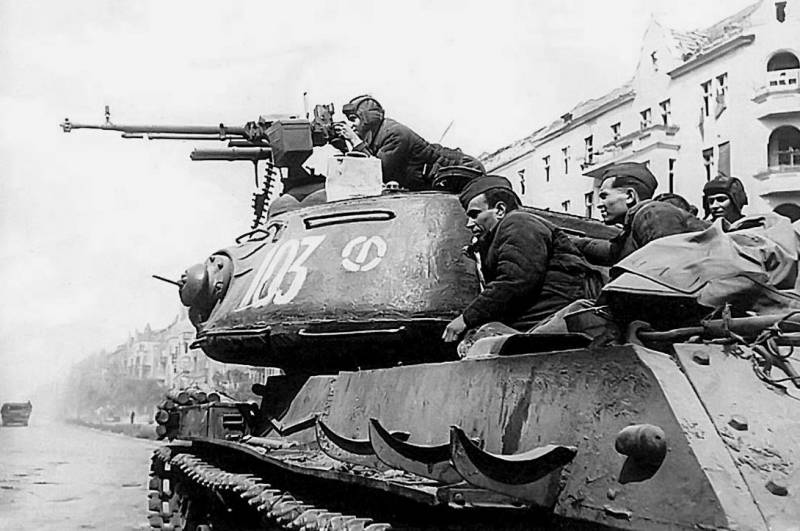
Tank IS-2 of the 110th Guards Heavy Tank Regiment of the 67th Guards. otbr
Three tank regiments of the 11th Guards. Ottbr, having a total of 48 IS-2 tanks, reached the next line by 16:00 on April 19: the 90th Guards. TTP crossed the highway two kilometers west of Grunov. 91st Guards. TTP was in the area 2,5 km south of Grunov, and the 92nd Guards. TTP passed Pritzhagen. Over the past day, the loss of the brigade amounted to only 3 IS-2 burnt out.
The 1504th sap, equipped with SU-76 self-propelled guns, was in the second echelon on April 19 and moved in the direction between the Grunov-Bukov points near Bollersdorf, did not fight that day and had no losses.
Separate self-propelled artillery battalions of the rifle divisions of the 5th UA also did not suffer any massive losses on April 18–19. On the evening of April 18 in the divisions of the 9th, 32nd and 26th Guards. ck there were a total of 100 self-propelled guns SU-76. On the evening of April 20, this number dipped by only 5 SU-76s, three of which were damaged by artillery fire and mines on April 16–17.
On the night of April 17-18, the 220th separate tank brigade occupied Vulkov, where it entrenched itself. At that time, 220 T-14-34 tanks and 85 ISU-14 self-propelled guns remained in service in the 122th brigade. On April 18, at 10:00 am, the brigade, together with units of the 301st Rifle Division (mainly from the 1052nd Rifle Division), set out in the direction of Hermersdorf, which, after a two-hour battle, was occupied by 14:00. During the battle, one T-34 tank was hit by artillery fire, and for the evening the brigade had 16 T-34s and 15 ISU-122s in service (several vehicles were out of repair).
On April 18, the brigade, in cooperation with units of the 301st SD, continued the offensive, being subjected to strong opposition from the master's court Bollersdorf and from a height of 77,0 in the Bukov area. By 17:00 on April 18, the 220th brigade was suspended at the turn of the stream in the area of \u11b\u00bthe mill, east of Bukov. Tanks and self-propelled guns of the brigade provided fire from the spot to our infantry, who crossed the stream and began the construction of the bridge. By 19:220 on April XNUMX, the construction of the bridge was completed, and the XNUMXth brigade continued its offensive through the forest to Bukov.
During April 19, one ISU-122 was shot down in the brigade, and by the evening there were 17 T-34s and 16 ISU-122s in service. By 21:30, the enemy was driven out of Bukovo, and the 220th brigade entrenched itself on its northern outskirts, replenishing ammunition and fuel without any excesses.
The next day, the 220th brigade continued its offensive from early morning and in the battles for Bollersdorf and Hasenholz suffered heavy losses from anti-tank fire, anti-aircraft guns and enemy tanks, due to which all the remaining combat-ready materiel (8 T-34 and 16 ISU-122 ) was consolidated into one battalion. The losses of the brigade on April 20 amounted to 10 T-34s and 3 ISU-122s: 2 T-34s burned down from the fire of German tanks and artillery, 6 T-34s and 1 ISU-122 were hit, blown up by mines and damaged by artillery fire - another 2 T- 34 and 2 ISU-122.
There are several questions here. Perhaps it was this episode that was described in German memoirs, when one “Royal Tiger” of the 503rd SS TTB near the Bukov-Hazenholz road knocked out 11 Soviet tanks, however, in German memoirs, the battle dates from April 18, but confusion in dates and places or confusion events of different days into one battle - for memoirs, a common thing.
And isn’t it these 17 tanks and 16 self-propelled guns refueling on the outskirts of Bukovo that the 220th brigade could see Kerner, who estimated their number as more than 100 units of T-34 and IS-2 (the eyes of fear are big) and confused the ISU-122 with the IS- 2? Bukov is located near Bollersdorf, at a distance of about a kilometer, and confusion in determining the types of enemy armored vehicles occurred throughout the war, and this should not be given much importance.
If this is so, and Koerner did not invent the Soviet tanks he saw refueling, then it is possible that this was the equipment of the 220th brigade, with which he prudently did not get involved.
In this case, it is possible that the desire to receive the cherished Knight's Cross overpowered and, knowing that the command was far away and no one would (and could not) check his applications, he decided not to miss his chance and cheerfully reported on the destruction of six dozen Soviet tanks, generously pouring 25 frags to his partner. Well, or there was still a battle with the same 220th brigade (for example, a real battle on the morning of April 20), but it didn’t go at all the way the “sons of the Nibelungs” described it, and the Soviet losses amounted to only 13 T-34 units and ISU-122, really lost in this battle.
Сonclusion
Summing up all of the above, we can state that on April 19, 1945, in the area of \u503b\u80boperation of the "Royal Tigers" of the 12rd SS TB, Soviet armored units actually lost no more than XNUMX tanks and self-propelled guns in a day (burnt and knocked out), and suffered the greatest losses tank brigades of the XNUMXth Guards. mk.
Losses of Soviet units for April 19, 1945:
220th brigade: 1 SU-122 was hit,
11th Guards. otbr: burned 3 IS-2,
67th Guards. otbr: 4 burnt down, 3 IS-2s shot down,
396th Guards. tsap: 1 ISU-152 was hit,
65th brigade of the 11th tk: burned down 1, shot down 1 T-34-85,
12th Guards shopping mall: 29 burned down, 28 T-34-85 shot down,
219th brigade of the 1st MK: 3 M4A2s were shot down,
19th MBR of the 1st MK: 1 was burned down, 2 M4A2s were shot down.
At the same time, it must be understood that not all of this armored vehicles were lost solely from the fire of only 10 "Royal Tigers", since parts of several German divisions also operated on this sector of the front, which also had tanks and self-propelled guns, which, along with artillery and other means defeats actively fought and, as far as possible, knocked out Soviet tanks.
So it would be too optimistic to believe in the result declared by the SS tankmen - about 150 Soviet tanks allegedly destroyed in one day.
Well, specifically: the result declared by Karl Koerner should be greatly reduced to just a few tanks, which in reality he could well knock out on April 19, 1945.
Information